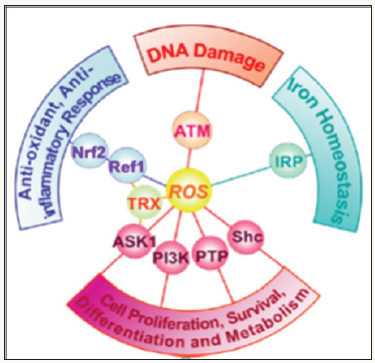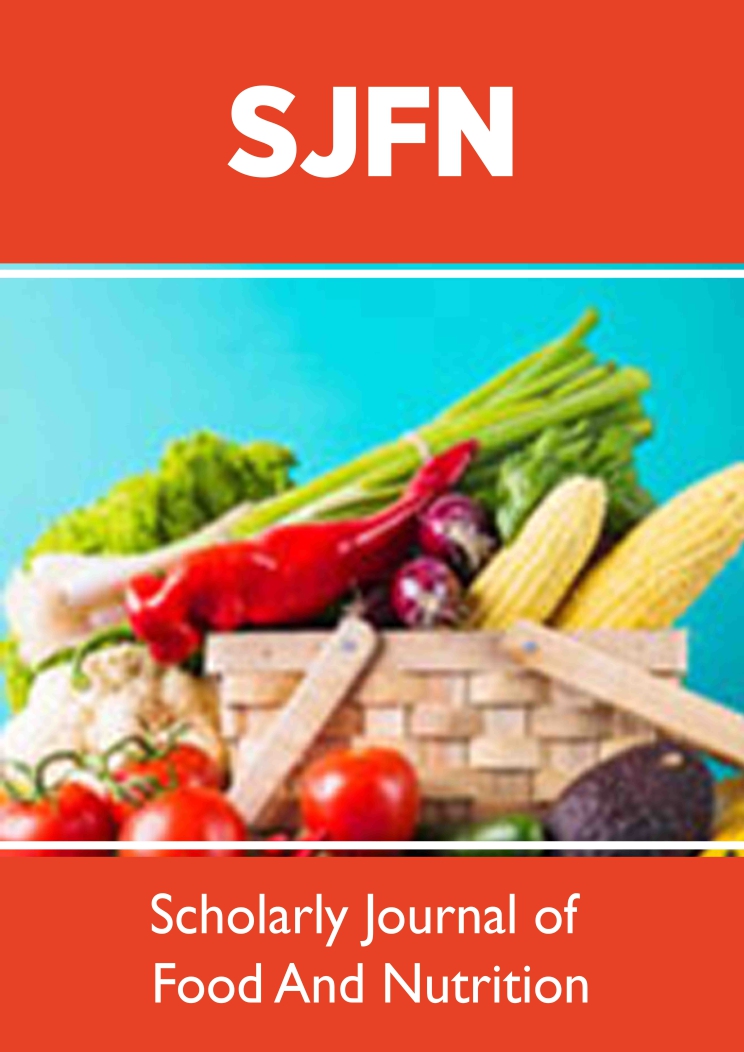
Lupine Publishers Group
Lupine Publishers
Menu
ISSN: 2638-6070
Mini Review(ISSN: 2638-6070) 
Should Reactive Oxygen Species (ROS) in Human Body be Controlled with Antioxidant Supplement?
Volume 1 - Issue 1Silvana D Harikedua*
- Department of Fish Processing Technology, Sam Ratulangi University, Manado, Indonesia
Received: May 05, 2018; Published: May 10, 2018
*Corresponding author: Silvana D Harikedua, Department of Fish Processing Technology, Faculty of Fisheries and Marine Science, Sam Ratulangi University, Manado, Indonesia
DOI: 10.32474/SJFN.2018.01.000103
Abstract
Oxidative stress in human body might cause degenerative disease which is trigger by reactive oxygen species (ROS). Antioxidant in foods or in supplements offers an ability to reduce detrimental effect of ROS and free radicals in human. However, it can only be used to maintain human health rather than to cure disease.
Abbreviations: ROS: Reactive Oxygen Species, RF: Redox Factor, PTP: Protein Tyrosine Phosphatases, ATM: Ataxia-Telangiectasia Mutated, IRP: Iron Regulatory Protein, SH: Sulfihidryl, NOXROS: NADPH Oxidase-Derived ROS
Introduction
Nutraceutical or functional food industry become fastdeveloped industry nowadays. It is likely that consumers not only looking for healthy and nutritious food, but also food with functional benefits to their health. Nutraceutical and functional food products are widely available in the market, for example, isolated nutrients, dietary supplements, herbal products, or processed foods enriched with antioxidants. One benefit that is offered from those products is an antioxidant capacity, which can help reduce the reactive oxygen species in our body.
From the biochemistry perspective, Reactive Oxygen Species (ROS) in the human body can act as double-edged sword. It plays an important role in signalling molecule reaction, but it is also responsible for the oxidative stress that can lead to degenerative disease. This essay will focus on recent studies related to the two faces role of ROS in the human body. This review also will highlight the use of antioxidant supplement in human health.
What is ROS?
Reactive Oxygen Species (ROS) are “a group of small oxygencontaining free radicals that are extremely reactive due to their unpaired valence electron” [1].There are three reactive oxygen species (ROS) form, i.e. superoxide radical, hydrogen peroxide and hydroxyl radical [2]. Reactive Oxygen Species (ROS) can cause oxidation of cells and tissues and they usually unstable, highly reactive, and energized molecule [3]. Moreover, ROS in biological systems can be formed by prooxidative enzyme systems, lipid oxidation, irradiation, inflammation, smoking, air pollutants, and glycoxidation [3].
ROS and Cell Signalling
ROS formation in the human body as a result of natural consequences of aerobic metabolism. In normal conditions, ROS can act as immune system modulation and can activate various signal transduction pathways[2]. Figure 1 showed the critical function of ROS in human metabolism. For example, PI3 kinase and Protein Tyrosine Phosphatases (PTP) play an important role in cells proliferation and survival to growth, hormone and cytokine stimulation; Redox Factor 1 (Rf1) and Nrf-2 responsible for the antioxidant and anti-inflammation regulation; Iron Regulatory Protein (IRP) can affect the iron homeostatis, and Ataxia-Telangiectasia Mutated (ATM) can regulate the DNA damage response. Additionally, ROS can influence a number of growth factors such as angiotensin in smooth muscle growth [4]. NADPH Oxidase-Derived ROS (noxROS) can kill foreign organism as part of the immune defense system in a low and intermediate concentration [1].
ROS and Diseases
ROS in the human body can cause detrimental effects such as alteration of membrane organization and functional loss of protein, enzymes and DNA, which eventually lead to various diseases and accelerated aging [5]. For instance, 8-hydroxydeoxuguanosine can oxidize DNA, protein oxidation might cause carbonyl modifications and loss of Sulfihidryl (SH) group from protein, ratio of redox couples such as glutathione: oxidized glutathione, NADPH:NADP+, and NADH:NAD+ will tend to shift to a more pro-oxidant value. It seems that the oxidation process is depending on age. Overload oxidative stress and abundant amounts of lipid peroxidation products can produce toxic and cause detrimental effects to biomolecules and generate pathogenesis oxidative stress-related disease such as, atherosclerosis, vasospasms, cancers, trauma, stroke, asthma, hyperoxia, arthritis, heart attack, age pigments, dermatitis, cataractogenesis, retinal damage, hepatitis, liver injury, and periondontis (Figure 2).
Figure 2: Figure 2: Clinical conditions involving reactive oxygen species. Source: Lee [3].

ROS and Antioxidant
Antioxidant levels are important in promoting health [6]. Antioxidant nutraceutical with 3 to 5 servings from vegetable group and 2 to 4 servings from the fruit group (USDA/CNPP 2000) can lessen the harmful effect of ROS and free radicals; thus, it might slow the aging process [3]. However, the used of antioxidant supplement in human is much more complicated than the simple reaction of free radical scavengers. Naturally, cells are equipped with antioxidant enzymes i.e superoxide dismutase, catalase, glutathione peroxidase, glutathione disulfide reductase, glutathione-stransferase, methionine sulfoxide reductase, and peroxidase[7]. It is likely that the used dietary antioxidant supplementation might disturb the mechanism of other natural antioxidants in cell. Furthermore Lee et al. [3] reported that an antioxidant can prevent lipid oxidation if the reduction potential of a free radical scavenger is lower than a reduction of potential PUFA (600mV). For instance, ascorbic acid (vitamin C) and tocopherol (vitamin E) which have lower standard 1-electron potential (282 and 480 mV, respectively) than PUFA 600 mV, can donate a hydrogen atom to peroxyl radicals of PUFA before PUFA does it. Likewise, Hensley et al. [6] noted that the concentration of α-tocopherol by 50 to 1000mg/ day can give advantages to human; although, it has not shown on epidemiological statistics. Apparently, natural antioxidants are not sufficient to control the oxidative stress in the human body that is why antioxidant supplement can only be used to enhance the cellular antioxidant capacity. Nevertheless, at some point antioxidants supplements might be unfavorable since they could diminish the adaptive signals of ROS. Chen & Niki [5] suggested that to utilize the lipid peroxidation products so that it can have beneficial effects. They proposed that the time, amount and site of their formation should be well-controlled and programmed [5]. Thereby, the used of exogenous antioxidant should be based on the bioavailability of the products. “Bioavailability can be defined as the amount of the percentage of an ingested nutrient that is absorbed and thus available to the body for metabolic use” [3].
Conclusion
In conclusion, it seems that antioxidant supplements can be used to control reactive oxygen species in human body. This essay shows that despite the fact that reactive oxygen species can initiate cell signalling, it might be endangered human life if it available in exceeds amount. Future research into the relation between each disease with reactive oxygen mechanism and the use of antioxidant to control reactive oxygen species in human body should be performed widely. It is proposed that antioxidant supplement should be considered as an aid to maintain a health. However, the lifestyle and eating behavior is highly important factor in reducing the oxidative stress which related to reactive oxygen species. Eating fruits, vegetables, spices, herbs and beverages such as wine, tea and coffee might balance oxygen reactive species in the body. Ultimately, since it is related to human life extension, antioxidant supplement should be considered as an appropriate food supplement.
References
- Patten DA, Germain M, Kelly MA, Slack RS (2010) Reactive oxygen species: stuck in the middle of neurodegeneration. J Alzheimer’s Disease 20: S357-S367.
- Seifried HE, Anderson DE, Fisher EI, Milner JA (2007) A review of the interaction among dietary antioxidants and reactive oxygen species. J Nutritional Biochemistry 18(9): 567-579.
- Lee J, Koo N, Min DB (2003) Reactive oxygen species, aging, and antioxidative nutraceuticals. Comprehensive Reviews in Food Science Food safety 3(1): 21-33.
- Magder S (2006) Reactive oxygen species: toxic molecules or spark of life? Critical Care 10(1): 208.
- Chen ZH, Niki E (2011) Two faces of lipid peroxidation products: the Yin and Yang principles of oxidative stress. J Experimental Integrative Medicine 1(4): 215-219.
- Hensley K, Robinson KA, Gabbita P, Salsman S, Floyd RA (2000) Reactive oxygen species, cell signaling, and cell injury. Free Radical Biology & Medicine 28(10): 1456-1462.
- Castro L, Freeman BA (2001) Reactive Oxygen Species in Human Health and Disease. Nutrition 17(2): 161- 165.
- Ray PD, Huang BW, Tsuji Y (2012) Reactive Oxygen Species (ROS) homeostasis and redox regulation in cellular signaling. Cellular signaling 24(5): 981- 990.

Top Editors
-

Mark E Smith
Bio chemistry
University of Texas Medical Branch, USA -

Lawrence A Presley
Department of Criminal Justice
Liberty University, USA -

Thomas W Miller
Department of Psychiatry
University of Kentucky, USA -

Gjumrakch Aliev
Department of Medicine
Gally International Biomedical Research & Consulting LLC, USA -

Christopher Bryant
Department of Urbanisation and Agricultural
Montreal university, USA -

Robert William Frare
Oral & Maxillofacial Pathology
New York University, USA -

Rudolph Modesto Navari
Gastroenterology and Hepatology
University of Alabama, UK -

Andrew Hague
Department of Medicine
Universities of Bradford, UK -

George Gregory Buttigieg
Maltese College of Obstetrics and Gynaecology, Europe -

Chen-Hsiung Yeh
Oncology
Circulogene Theranostics, England -
.png)
Emilio Bucio-Carrillo
Radiation Chemistry
National University of Mexico, USA -
.jpg)
Casey J Grenier
Analytical Chemistry
Wentworth Institute of Technology, USA -
Hany Atalah
Minimally Invasive Surgery
Mercer University school of Medicine, USA -

Abu-Hussein Muhamad
Pediatric Dentistry
University of Athens , Greece

The annual scholar awards from Lupine Publishers honor a selected number Read More...





